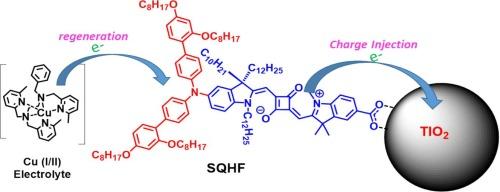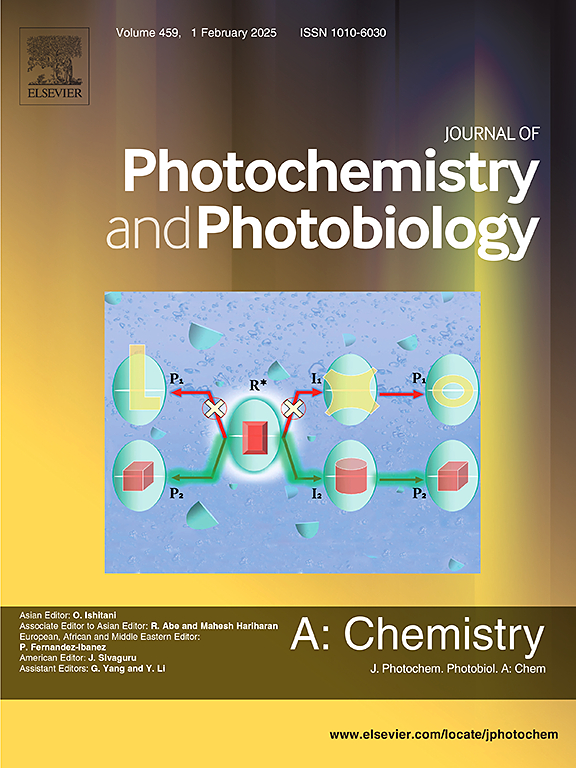Far-red active squaraine dye-sensitized photoanode for dye-sensitized solar cells with a copper (II/I) electrolyte
IF 4.1
3区 化学
Q2 CHEMISTRY, PHYSICAL
Journal of Photochemistry and Photobiology A-chemistry
Pub Date : 2024-10-12
DOI:10.1016/j.jphotochem.2024.116086
引用次数: 0
Abstract
In dye-sensitized solar cells (DSSC), controlling the dye-aggregation on TiO2 and charge recombination between electrons present in TiO2 and electrolyte can be achieved by wrapping the long alkyl groups around the dye structure and further introducing bulky donor on the dye is a potential approach to enhance both the open-circuit potential and short-circuit current parameters. Additionally, bulky donor containing dye structures modulates the photophysical and electrochemical properties of the sensitizer which helps reducing the over potentials required for the dye regeneration process by utilizing a multidentate ligand containing [Cu(tme)]2+/+ and I−/I3− redox electrolytes. Hagfeldt donor appended far-red NIR active unsymmetrical squaraine dye (SQ-HF) has been designed, synthesized, and characterized. SQ-HF dye showed an intense absorption at 676 nm (ε 1.7 × 105 M−1cm−1). Photophysical and electrochemical studies indicated that the LUMO and HOMO energy levels of the SQ-HF dye were suited for charge injection (from the LUMO of the dye to the conduction band of TiO2) and dye-regeneration processes, respectively. The DSSC device efficiency of 5.15 % (JSC of 10.83 mA/cm2 and VOC of 0.690 V) has been achieved for SQ-HF dye by utilizing a literature reported [Cu(tme)]2+/+ and 4.11 % (JSC of 8.74 mA/cm2 and VOC of 0.702 V) in I−/I3− redox shuttles, respectively.

用于铜 (II/I) 电解质染料敏化太阳能电池的远红活性方碱染料敏化光阳极
在染料敏化太阳能电池(DSSC)中,控制二氧化钛上的染料聚集以及二氧化钛中的电子与电解质之间的电荷重组,可以通过在染料结构上缠绕长烷基并在染料上进一步引入大块供体来实现,这是一种提高开路电位和短路电流参数的潜在方法。此外,含有大块供体的染料结构还能调节敏化剂的光物理和电化学性质,通过利用含有[Cu(tme)]2+/+和 I-/I3- 氧化还原电解质的多叉配体,有助于降低染料再生过程所需的过电位。我们设计、合成并表征了哈格菲尔德供体附加远红外线近红外活性不对称鳞片染料(SQ-HF)。SQ-HF 染料在 676 纳米波长处有强烈吸收(ε 1.7 × 105 M-1cm-1)。光物理和电化学研究表明,SQ-HF 染料的 LUMO 和 HOMO 能级分别适合电荷注入(从染料的 LUMO 到 TiO2 的导带)和染料再生过程。通过利用文献报道的[Cu(tme)]2+/+和 I-/I3- 氧化还原穿梭器,SQ-HF 染料的 DSSC 器件效率分别达到了 5.15%(JSC 为 10.83 mA/cm2,VOC 为 0.690 V)和 4.11%(JSC 为 8.74 mA/cm2,VOC 为 0.702 V)。
本文章由计算机程序翻译,如有差异,请以英文原文为准。
求助全文
约1分钟内获得全文
求助全文
来源期刊
CiteScore
7.90
自引率
7.00%
发文量
580
审稿时长
48 days
期刊介绍:
JPPA publishes the results of fundamental studies on all aspects of chemical phenomena induced by interactions between light and molecules/matter of all kinds.
All systems capable of being described at the molecular or integrated multimolecular level are appropriate for the journal. This includes all molecular chemical species as well as biomolecular, supramolecular, polymer and other macromolecular systems, as well as solid state photochemistry. In addition, the journal publishes studies of semiconductor and other photoactive organic and inorganic materials, photocatalysis (organic, inorganic, supramolecular and superconductor).
The scope includes condensed and gas phase photochemistry, as well as synchrotron radiation chemistry. A broad range of processes and techniques in photochemistry are covered such as light induced energy, electron and proton transfer; nonlinear photochemical behavior; mechanistic investigation of photochemical reactions and identification of the products of photochemical reactions; quantum yield determinations and measurements of rate constants for primary and secondary photochemical processes; steady-state and time-resolved emission, ultrafast spectroscopic methods, single molecule spectroscopy, time resolved X-ray diffraction, luminescence microscopy, and scattering spectroscopy applied to photochemistry. Papers in emerging and applied areas such as luminescent sensors, electroluminescence, solar energy conversion, atmospheric photochemistry, environmental remediation, and related photocatalytic chemistry are also welcome.

 求助内容:
求助内容: 应助结果提醒方式:
应助结果提醒方式:


